Have you been trying to translate your brilliant idea into an ad campaign copy but do not know where to start?
If so, congratulations, you are in the right place. Today, you will learn to master the art of ad copywriting.
Sounds awesome 🤩
In today’s crowded and competitive advertising landscape, having the right ad campaign copy structure that stands out is essential.
Even if you have a fantastic product or service, your ad will get lost in the noise if you do not have solid ad copy.
So, to differentiate yourself from others, you should have strong ad copy that grabs the attention of your target audience.
You must remember that you are wrong if you think copywriting is just an innate talent.
It’s a skill that you should only learn with practice and the proper guidence.
In this guide, I will show you how to write integrated ad campaign copy, whether you are a beginner who wants to start your career as a copywriter, a small business owner, an entrepreneur, a seasoned marketer, or anyone who wants to learn to craft ad copy.
This guide is for you.
After completing this guide, you can crack or write a brand brief and learn how to write your ad campaign copy according to the brief.
Note: Read this guide entirely because each step is connected with the next step.
So, without wasting time, let’s start.
The Brief
Consider the brief a roadmap. It is the foundation of every campaign, and without it, a campaign cannot be done correctly.
It helps you understand campaign goals, its target audience, and other key campaign elements.
Moreover, it helps you, your team, and clients to be on the same page.
In this section, I will discuss the campaign brief in detail, which includes:
- Key elements of the Brief.
- Steps to create an effective brief.
- Project for you.
Let’s discuss each one individually in detail.
Key Elements of the Brief
To understand the key elements of Brief, you need to address the following questions:
Who is For?
The first thing you have to know is that it includes a client or brand, which means you need to first identify who your client and brand are, their vision, mission, and overall goals.
Who are you talking to?
It is all about your target audience. Here, make a persona of your potential customers. Who are they? This includes their demographics, psychographics, behavior, values, interests, and pain points. By addressing this question, you can understand who your audience is. This will help you tailor the right message that grabs their attention.
What are we making?
Here, Specify what type of content you need, whether it will be digital video content, social media posts, Television video commercials, or something else. This point helps identify the deliverables and clarifies the project’s requirements.
Where is it going to live?
It includes where your campaign will be displayed, whether on social media, a website, in print, on TV, or elsewhere. By addressing this question, you can determine the length, visual elements, and appropriate tone.
When’s the deadline?
Here, you determine the project deadline. This will help align you and your team members. It includes the final delivery and Key milestones of the project.
After addressing key elements, let’s discuss the steps to create a Brief:
Steps to create an effective brief
Step 1: Gather information
You can only work on a brief if you know the brand you will work for. So step one is all about gathering the information about:
- Competitive Landscape.
- Brand guidelines.
- Target audience.
- Existing research work.
Step 2: Define Objective
In step 2, determine the campaign’s objective: What do you want to achieve, whether brand awareness, lead generation, sales drive, etc.? Remember, your objective should be achievable, measurable, specific, time-bound, and relevant.
Step 3: Identify Key Message
In this step, determine the campaign’s key takeaways and the core message the ad should communicate. The message should align with the brand voice and values you want to deliver to your audience.
Step 4: Outline Creative Requirements
These steps define the creative requirements needed to create the ad campaign copy. They include style, tone, alignments, and other specific elements that must be written clearly. This helps you align properly with the creative team.
Step 5: Media mix
In this step, define the channels where you want the campaign displayed. This includes social media, TV, newspapers, magazines, Billboards, etc. Every platform has its content guidelines, so by determining the channel, you can align the message accordingly.
Step 6: Set Budget
In this step, set the budget for the overall campaign, for example, how much you want to spend on digital channels like Facebook, YouTube, etc., and how much on other channels like billboards, magazines, etc.
If you are working on the project independently, you can create your Brief by following these steps. However, if you are a copywriter, you will get a brief document from a strategist or from your client.
In this blog further, we will work on one project where we work on the project, and we will write a copy accordingly.
Project For You

Write Headline
For any ad campaign, the headline acts as a workhorse. It is the first impression and acts as an initial hook, so it is very important to make it captivating in order to drive the attention of your target audience.
So, in this section, I am going to discuss how you can craft headlines with the help of six best practices, which are:
Keep it simple
Craft your headline in a way that is easily remembered. Simplicity is the key: avoid complex phrases and jargon, keep it concise, and avoid unnecessary information.
Keep it Authentic
Remember, once trust is broken, sorry does not mean anything in your headline. Never make false claims. Keep it authentic because authenticity builds trust.
Make it Emotive
Emotions play an important role in grabbing attention and creating lasting impact. Headlines that evoke emotion are more likely to be remembered.
Make it Unique
Uniqueness is the key to separating yourself from the crowd. It helps you pique the curiosity of your target audience.
Make it Visual
Craft your headline so that your target audience can visualize the experience they can get. It should make an impact, helping them to paint a picture in their mind.
Choose words wisely
You have very little word space in headline writing, so every word counts. So, when choosing words, make sure they maximize your impact and are relevant to your target audience.
Let’s write headlines for our brand Volt Cycle with the help of the following practices.
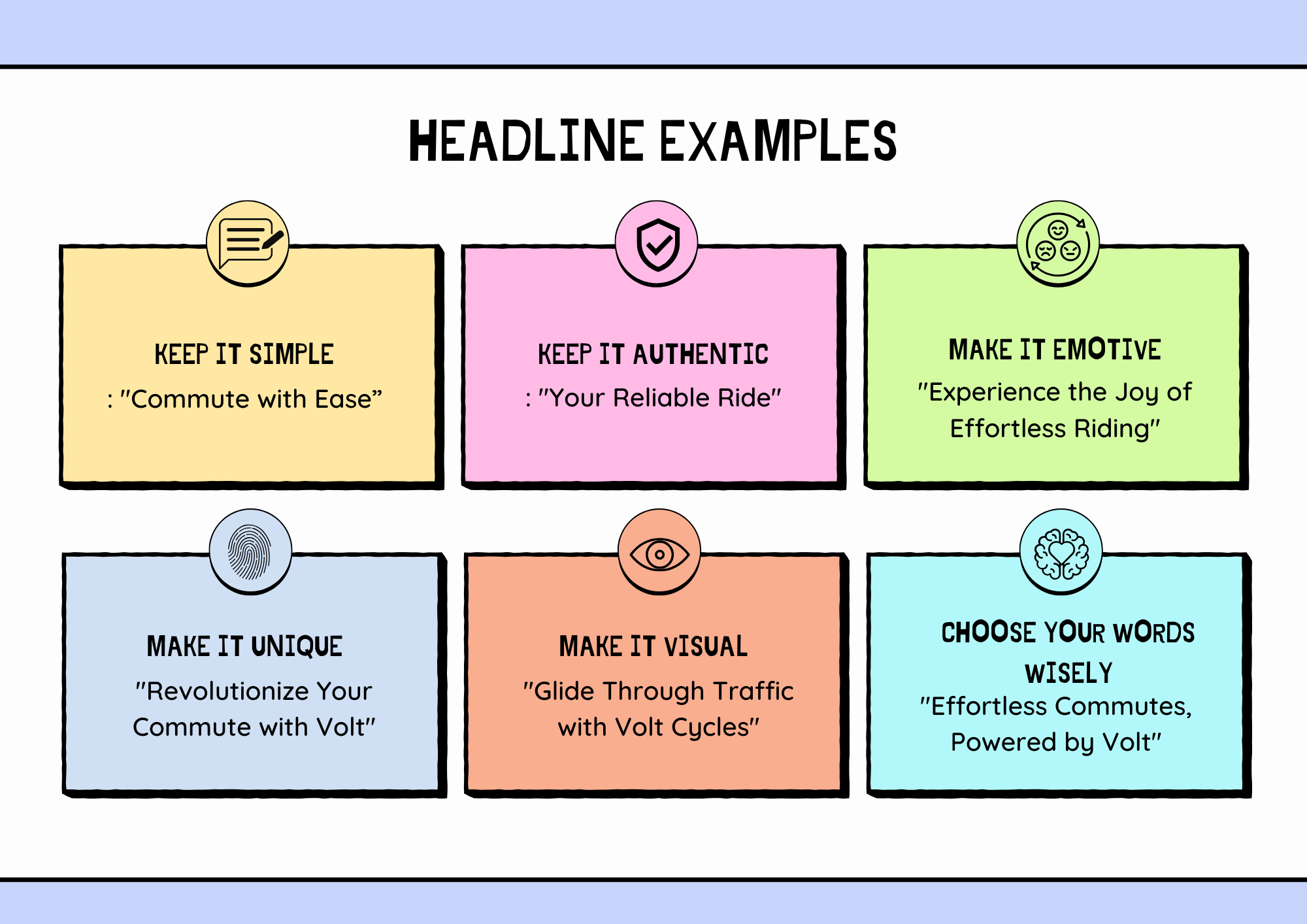
By following the best headline writing practices—unique, simple, authentic, emotive, well-chosen words and visuals—which we have discussed above, you can craft attention-grabbing headlines for your brand.
Moreover, with the help of headlines, you can establish your clear brand voice, which you want your target audience to recognize who you are.
Ultimately, a perfect headline helps you make your brand manifesto.
Let’s discuss the brand manifesto, what it is, and how to make it.
Brand Manifesto
Brand manifesto is your brand narrative that communicates its purpose and identity. Do not think of it as only a simple mission statement. It is more than that because it defines the brand’s vision, impact, and values.
Let’s write the Brand Manifesto of the Volt cycle.
In order to write a perfect Brand Manifesto, you first need to put yourself in your customer’s shoes and then tell a story that embodies a brand.
Consider three key questions when writing a brand manifesto:
- What problem are you solving?
- Why do you do what you do?
- How are you different from others?
Let’s answer these for volt cycles.
What problem are you solving?
Volt Cycle’s electric bike is cost-effective and designed to make commuters’ lives easier. It addresses the challenges they face in their daily routine, including time and money waste and safety concerns.
Why do you do what you do?
Volt Cycles believes in enhancing commuters’ lives by providing hassle-free transportation in the form of sustainable, accessible, and reliable electric bikes.
How are you different from others?
Volt Cycle’s electric bikes are lightweight, cost-effective, and elegant. They are also easy to use and prioritize convenience.
After answering questions, let’s write a complete Brand Manifesto:
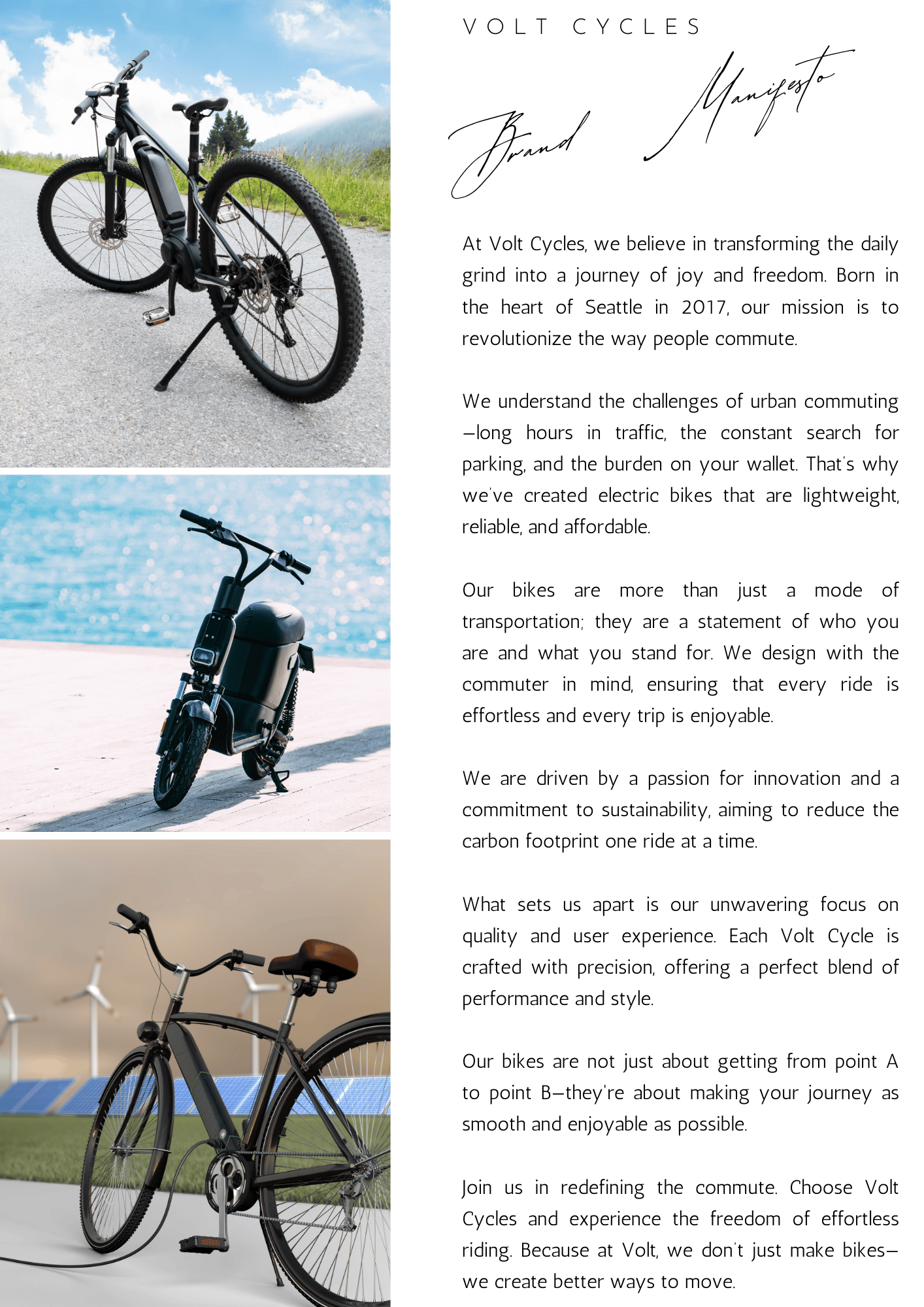
AD Copy
After understanding how to write a headline and crafting a brand manifesto, it’s time to work on the main ad copy of our ad campaign.
In this section, we will work on the following:
- Big idea.
- Ad concept.
- Script of the ad.
Big Idea
The big idea works as a foundation in any ad campaign. In simple words, it is the central message, or you can say it is a hidden value that we incorporate in the ad to enhance the brand’s value.
Every big idea includes the brand’s core message, unique selling point, and emotional appeal. The idea behind making the idea is to make the ad campaign impactful and memorable.
Ad Concept
After creating a big idea, we need to craft its creative execution. The ad concept comes here. We define the story behind a message presented in an ad.
An ad concept mainly contains copy, visual elements, tone of voice, and other core elements that are essential to communicating the big idea.
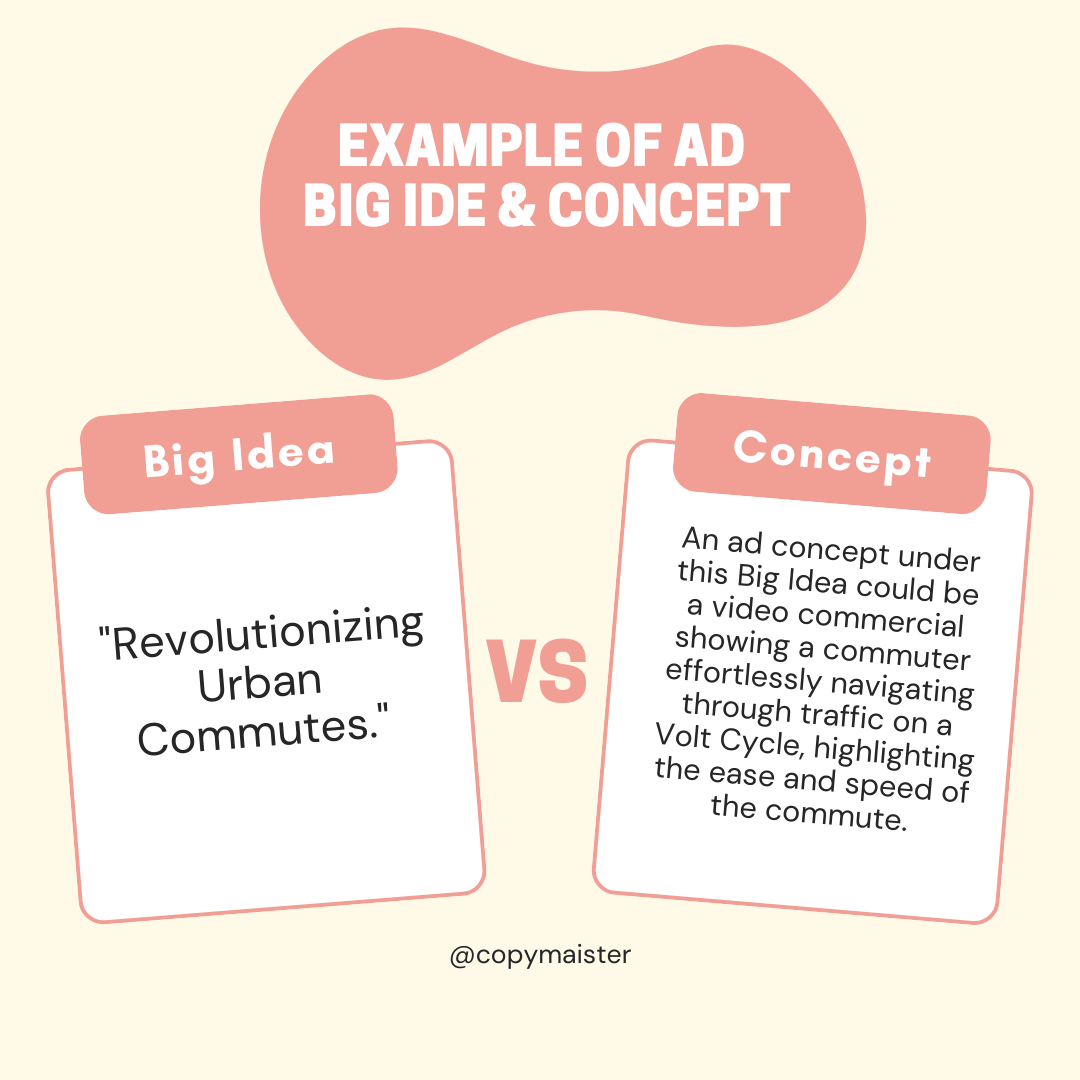
So, after the ad concept, we start to work on making a copy as per the brief requirement in our brief. We are required to make:
- 1 video commercial.
- One radio spot.
- One Billboard.
- One social media post.
But before execution, I will first discuss the things required to make these all requirements. After this, we will craft a copy for each.
Let’s first start with:
Script
In this section, we are going to learn how to write commercial scripts for Video ads and radio. A script is a written document that describes an ad format, including Dialogue, direction, and actions.
Let’s discuss how to write a script for two main formats which are:
- Video Commercial.
- Radio Spot.
Video Commercial
Video commercials are the best way to engage with the target audience because they create a sense of story. They include music, sound effects, and visuals.
To create a copy for a video commercial, you need a script that consists of six things:
- Story.
- Environment ScreenPlay (Seens).
- Activity.
- Expressions.
- Activity.
- Dialogues.
Story
The story is the first step in defining the narrative framework. It includes:
- Characters: Here, we define the entities the people work in in a way that resonates with your target audience.
- Settings: Here you define the context or environment in which the story takes place.
- Plot: Here you define the order of the events that unfold within your ad.
- Conflict: Here, you define problems, pain, and challenges your character face.
- Resolution: Here you conclude the ad where you show how conflict is resolved.
Example of Story:
Here is see the picture and analyze how the story is mentioned:
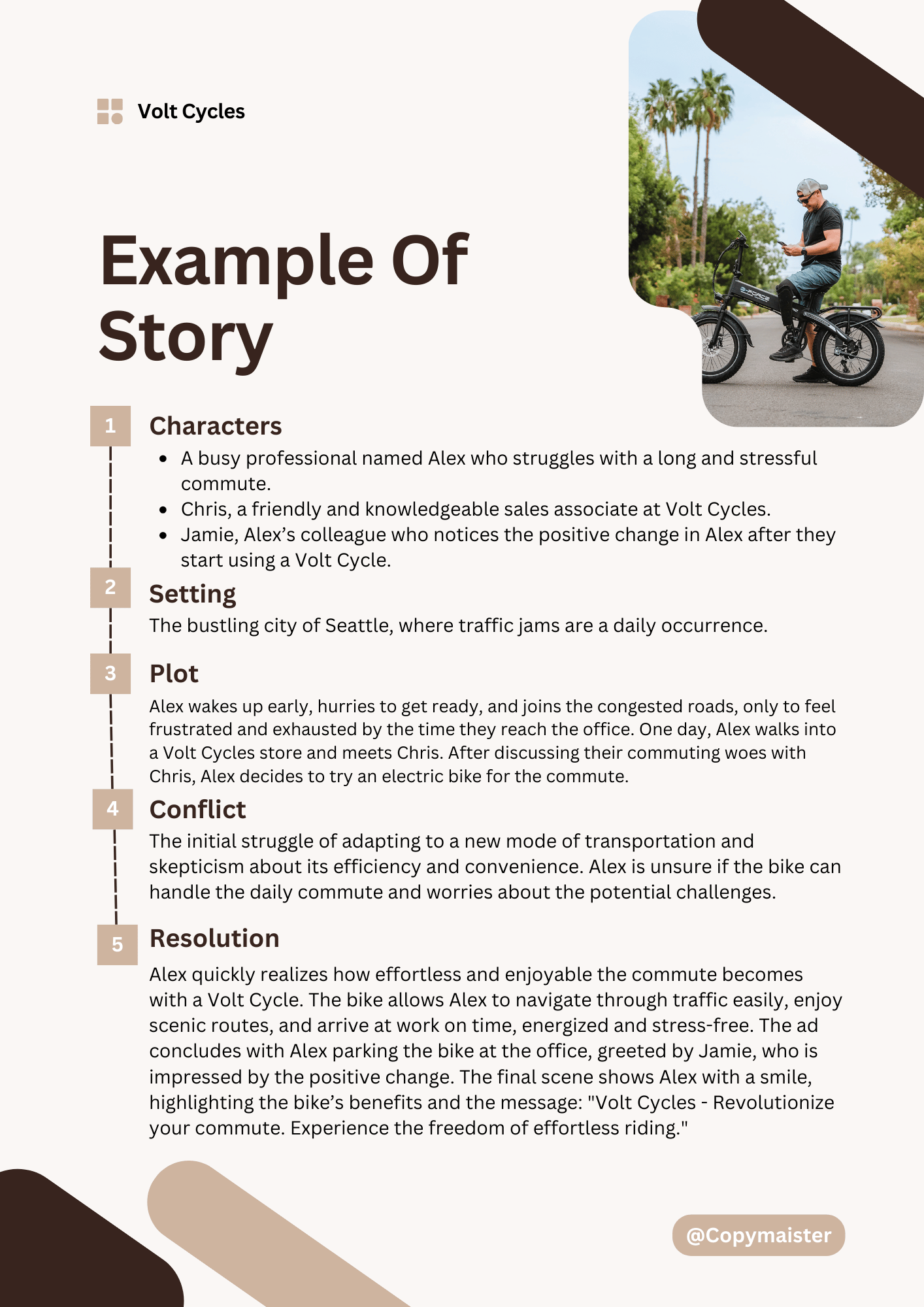
After crafting a story, you can make an ad copy. Let’s discuss other essential factors and copy the script format.
Environment (ScreenPlay):
here, you define the scene of what the character is doing.
Expression:
here, you define character expression, for example, seems tired, looks happy, etc
Activity
here you define what the character is doing.
Dialogue
This is the main way to craft spoken conversation into writing dialogues. There are the following tips you can follow.
- To create Dialogue, watch existing ads and brainstorm, focusing on the Dialogue’s flow, which includes tone, context, and pacing.
- Write as you talk; it makes your dialogues conversational and natural.
- In order to keep your dialogue dynamic, break it with Action.
- Give each character a unique voice and personality.
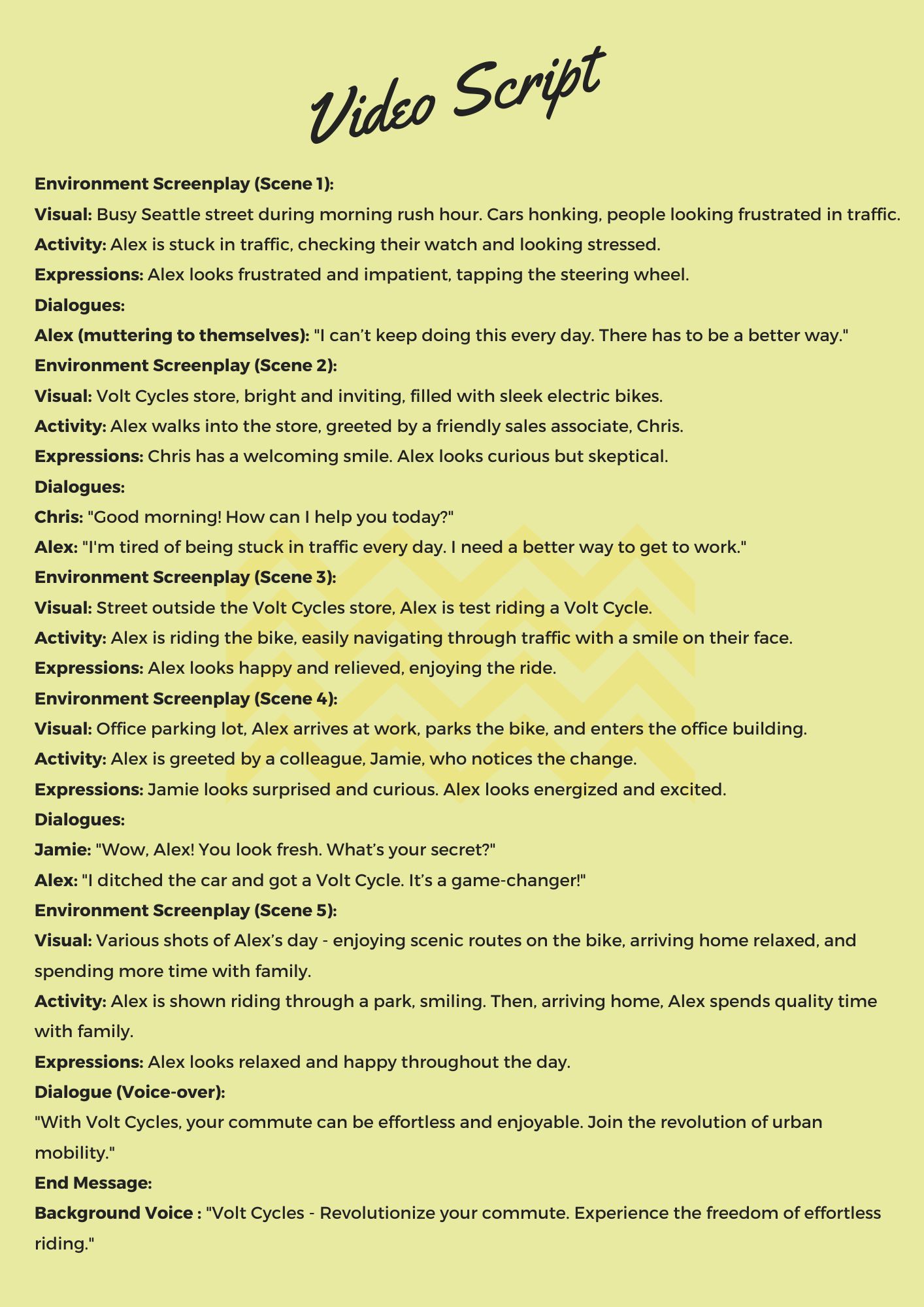
Radio Spot
Writing copy for a radio spot is a big challenge because here, you only have sound effects to engage your target audience. So, in order to write attention-grabbing copy, here are valuable tips you should follow.
- Be concise, and avoid crafting long and complex narratives.
- Do not add too many characters’ voices; doing so will make the spot confusing. Limit your characters to ensure they do not overwhelm the listener.
- Distinguish your character’s voice and make sure the character’s voice should be identifiable.
- Try to keep your radio spot as short as possible. The best practice is to make it a maximum of 30 seconds long.
- Be detailed in your character description. Make sure you understand the narrator’s personality and tone; this will help you in your scripting style.
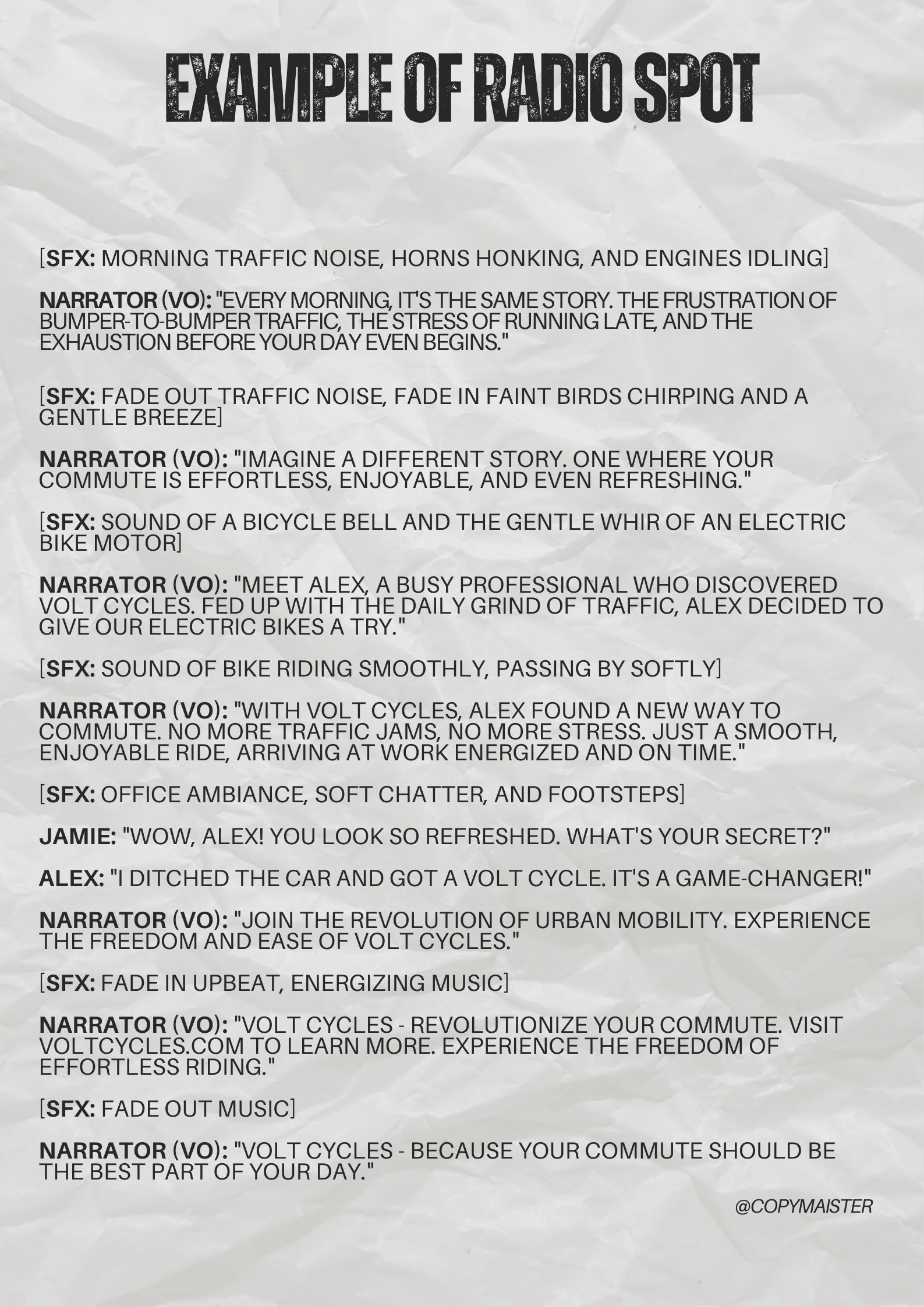
Billboard + Social media post copy
There are three essentials in Billboard and social media copy: headline, subheadline, body of copy, and call to Action. We have already discussed headlines in detail.
So, all you need to know is the subheadline, body of copy, and call to Action. In simple words, the subheadline is an extension of the headline, which you use to add more details to grab the attention of your target audience.
The body of the copy is where you define your offer in detail, and the call to Action is the desired Action you want your copy to take.
Example of Billboard Copy:
Headline: “Revolutionize Your Commute”
Subheadline: “Experience the freedom of effortless riding.”
Body Copy:
“Join the urban mobility revolution with Volt Cycles. Smooth, stress-free, and on time. Visit voltcycles.com to learn more.”
Call to Action: “Volt Cycles – Because your commute should be the best part of your day.”
Conclusion
So here we are at the end of our guide. I hope you now have a clear idea of how to write an ad on your own. In this guide, I have discussed the whole process from the start of ad copy work to the end.
First, I have shown you the brief’s key elements and how you can write your own brief. At the end of this section, I have maintained the brief for the volt cycle, and then throughout the whole guide, we have focused on that brief as a project.
Then, we explored how to write a headline and brand manifesto, where I covered techniques for writing a headline and, after writing a headline, how to craft a brand manifesto using a headline.
Lastly, I have shown you how to write ad copy, covering Big ideas, ad concepts, script writing, video commercial copy, radio spot copy, billboard copy, and social media copy.
By following the steps I have discussed with you, you can write a copy for an ad campaign; just practice is needed.
Lastly, I want you to write an ad campaign for any brand you want and email it to me. Take it as your assignment, and if you have any further questions, you can email me.

